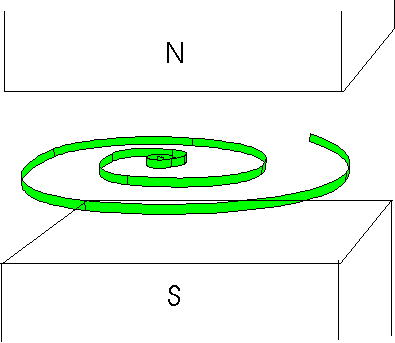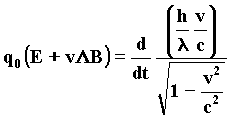|
The wave interpretation of the Lorentz force
In the phenomenon really experimented in bubble chamber, the effect of the Lorentz force diverge in opposite direction the positron and electron traces.
According to the Wave Field Theory, the Lorentz force bends the trajectory of an electron when its spin is parallel to the lines of force of a magnetic field, and its velocity develops on a plane orthogonal to the spin.
In the wave language, this condition imposes the spherical involute to move in a plane passing through its resonance orbit.

When this condition appears, the wavefront is in different times in four phisically different conditions:
1) the wavefront, which moves in the resonance orbit and creates the involute, during its rotation proceeds firstly with velocity v in the same direction as the velocity of the center of the resonance orbit; therefore its wavelengt emitted in this direction gets shorter owing to Doppler effect;
2) secondly, it moves in a direction transversal to velocity, leaving its wavelenght unchanged;
3) thirdly, it moves in a direction opposite to velocity, increasing the wavelenght owing to opposite Doppler effect;
4) finally, it moves in a direction transversal and opposite to the previous one, leaving the wavelenght unchanged and returning to the first condition in order to repeat the whole cycle again.

During the whole rotation, the resonant wavefront, that is subjected to relativistic Doppler effect, produces a deformed involute with an accumulation of wavefronts by the side of the spherical involute, causing on the plane an asymmetrical variation in the wavelength of the waves emitted orthogonally with respect to velocity.
70)

q0 is the elementary charge,
E is the electric field pushing at velocity v the electron which crosses the magnetic field
B with the spin parallel to its lines of force.
Due to the relative symmetry principle, this causes a thrust in the opposite direction and bends the trajectory of the spherical involute in a direction and that of its mirror image in the opposite direction.
An electron, that is not subjected to a magnetic field, travels in straight line because its spin without having a constraint on the orientation is placed in the direction of motion. This is its smallest energy position and the greatest symmetry condition for an asymmetrical structure like the spherical involute.
This explains the curl traces of charged particles in bubble chamber that losing velocity are in intermediary conditions: with the spin that does not lie on the velocity vector at all, nor is it completely orthogonal with respect to the plane of motion.
The wave variation triggering the reaction of the R.S.P. in Lorentz force propagates in space-time at the velocity of light as
a variation in wave energy; this is considered as a photon-wave train that is physically perceivable and capable of inducing in other particles some variations in momentum, and producing other known optical effects.
When the electron reaches some relativistic velocities, this wave variation has a specific correspondence in the experience and can be identified with the synchrotron radiation.
In order to make the wave interpretation of the Lorentz force more effective and the situation clearer, we should look for a plausible reason of the wave nature of electric charge, by investigating with full particulars the behavior of the resonant wavefront which is in the vicinity of the resonance orbit.
We shall deal with this subject further on. Now, let us make a stepback and go on to analyse the explicative possibilities of the simple model of mass considered as a generic source of elementary waves.
|


